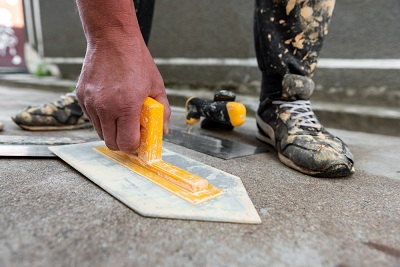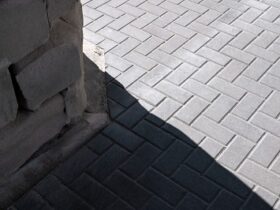Acid-stained concrete provides a rich, unique appearance that enhances both interior and exterior spaces. However, to preserve the beauty and longevity of the finish, proper sealing is essential. Sealing not only protects the surface but also ensures that the colors remain vibrant over time. In this comprehensive guide, we will explain the step-by-step process for sealing acid-stained concrete, including tips on selecting the right sealant and avoiding common pitfalls.
Why Sealing Acid-Stained Concrete is Crucial
Concrete is a porous material, and without a protective layer, it can absorb moisture, dirt, and other contaminants. This leads to staining, cracking, and a deterioration of the surface. The acid-stain process creates stunning effects on the concrete, but sealing is the only way to protect these results from wear and tear, UV damage, and moisture intrusion. Without a proper seal, even the most expertly stained concrete can lose its luster over time.
Benefits of Sealing Acid-Stained Concrete
- Enhances Durability: Sealing creates a hard, protective layer that increases the surface’s resistance to scratches, impacts, and other physical damage.
- Preserves Color: A high-quality sealer locks in the color and prevents fading caused by UV rays and environmental exposure.
- Moisture Protection: Sealed concrete is far more resistant to moisture penetration, reducing the risk of mold growth and efflorescence.
- Stain Resistance: Sealing also repels oil, grease, and other liquids, making the surface easier to clean and maintain.
Choosing the Right Sealant for Acid-Stained Concrete
There are several types of sealants available, each offering unique benefits depending on the environment and intended use of the surface. The two most common types for acid-stained concrete are acrylic-based sealers and epoxy/urethane-based sealers.
Acrylic-Based Sealers
Acrylic sealers are popular due to their affordability, ease of application, and fast drying time. They are ideal for indoor surfaces and light traffic areas. Acrylic sealers come in both water-based and solvent-based varieties, with each offering different advantages:
- Water-Based Acrylic Sealers: These are eco-friendly and have low VOC (volatile organic compound) levels, making them ideal for indoor use. They create a thin, breathable film that provides decent protection.
- Solvent-Based Acrylic Sealers: These offer a higher-gloss finish and are more durable than water-based sealers. However, they emit more fumes during application and are typically used outdoors.
Epoxy and Urethane Sealers
For high-traffic areas or surfaces exposed to heavy wear, epoxy or urethane sealers are more suitable. These sealants provide superior durability and protection compared to acrylic-based products. However, they can be more complex to apply and are generally more expensive.
- Epoxy Sealers: Known for their strength and chemical resistance, epoxy sealers create a tough, non-breathable barrier on the surface. They are perfect for industrial settings, garages, or commercial spaces where heavy foot traffic is expected.
- Urethane Sealers: Urethane sealers offer excellent resistance to abrasion, UV rays, and chemicals. They are often used in conjunction with epoxy for maximum durability.
Step-by-Step Guide to Sealing Acid-Stained Concrete
Step 1: Surface Preparation
Before applying any sealer, it’s critical to prepare the surface properly. Any debris, dust, or residue on the concrete can affect how well the sealer adheres. Here’s how to ensure the surface is ready:
- Clean the Concrete: Use a mild detergent and water to scrub the surface, removing dirt, oil, and stains. A power washer can also be used for outdoor surfaces. Allow the concrete to dry completely.
- Repair Cracks and Imperfections: If there are any cracks or imperfections in the concrete, fill them with a concrete patch compound and allow it to cure before proceeding.
- Neutralize the Acid Stain: After staining, the surface needs to be neutralized to stop the chemical reaction. Use a mixture of water and baking soda (or ammonia) to mop the surface, then rinse thoroughly and let the area dry completely.
Step 2: Choosing the Application Method
The method of application depends on the type of sealer you choose. Most sealants can be applied using a roller, sprayer, or brush. For larger surfaces, a sprayer is recommended for even coverage, while a roller or brush works well for smaller areas or detailed work.
Step 3: Applying the Sealer
- Test the Sealer: Always apply a small amount of sealer in an inconspicuous area first to ensure it provides the desired finish.
- First Coat Application: Start by applying a thin, even coat of sealer. Use smooth, overlapping strokes to avoid streaks and uneven patches. If using a roller, make sure to roll in one direction to maintain consistency.
- Allow Time to Dry: Allow the first coat to dry according to the manufacturer’s instructions, usually between 2-4 hours, depending on the type of sealer and environmental conditions.
- Apply a Second Coat: For added protection and a deeper finish, apply a second coat once the first one has fully dried. This is particularly important for high-traffic areas or outdoor surfaces exposed to the elements.
Step 4: Drying and Curing
Once all coats have been applied, allow the sealer to cure for at least 24-48 hours before walking on the surface or placing any objects on it. For outdoor surfaces, avoid exposure to moisture (rain or heavy dew) until the sealer has fully cured. Be mindful that curing times can vary depending on the climate and sealer type.
Tips for Maintaining Sealed Acid-Stained Concrete
Sealing acid-stained concrete isn’t the end of the maintenance process. Proper care and regular upkeep will help ensure that your surface remains vibrant and protected over time. Here are some key maintenance tips:
- Regular Cleaning: Sweep or dust the surface regularly to remove dirt and debris. For deeper cleaning, use a mop with a pH-neutral cleaner.
- Avoid Harsh Chemicals: Acidic or abrasive cleaners can damage the sealer and the stain beneath. Stick to mild, non-acidic cleaning agents.
- Reapply Sealer as Needed: Over time, the sealer will wear down, especially in high-traffic areas. Depending on the type of sealer and the amount of use, you may need to reapply it every 1-3 years.
- Avoid Excessive Moisture: Although the sealer provides moisture protection, prolonged exposure to standing water can still cause damage. Ensure proper drainage for outdoor surfaces, and wipe up spills promptly indoors.
Common Mistakes to Avoid When Sealing Acid-Stained Concrete
- Skipping Surface Prep: Inadequate surface preparation can lead to poor adhesion, bubbling, or peeling of the sealer.
- Applying Too Thick of a Coat: Thick coats can result in an uneven finish and prolong drying times. Always apply thin, even layers.
- Sealing Before the Stain is Fully Neutralized: Failing to neutralize the acid stain properly can lead to discoloration or poor sealer performance.
- Using the Wrong Sealer for the Environment: Indoor and outdoor environments have different demands. Choosing the wrong sealer can lead to premature wear, discoloration, or failure.
Conclution
Sealing acid-stained concrete is crucial for preserving its appearance and durability. Choose a high-quality sealer that suits your specific needs, whether it’s for indoor or outdoor use. Proper surface preparation, careful application, and regular maintenance are key steps to ensure a long-lasting finish. By sealing the concrete, you protect it from damage, enhance its color, and create an attractive, low-maintenance surface that can withstand wear and environmental factors effectively.







Find Us on Socials